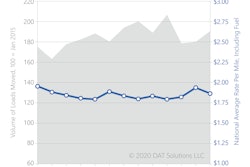
The two-year grace period that allows automatic on-board recording devices (AOBRD) to replace electronic logging device (ELD)-compliant devices expired last December. This means that food manufacturers with distribution fleets that did not upgrade to ELD-compliant devices but were operating under the AOBRD extension should already have made a commitment to an ELD provider and service. This also means that food manufacturer distributors that were operating on the AOBRD extension for the last two years are now faced with the same decisions that fleets had to make when the ELD mandate was initially put into place. Who do I select as my provider?
The ELD conversation for food manufacturers and their distributors is larger than just an hours-of-service (HOS) determination, especially for time-sensitive and temperature-sensitive operations due to the passing of the Food Safety Modernization Act (FSMA). ELDs are also part of a broader discussion about telematics and on-board computers, and the use of telematics to optimize data that comes from the truck as well as the use of that data for overall fleet compliance, analytics and operations.
ELDs can be a different technology than an AOBRD. ELDs are not required to capture all the operating data that your AOBRD may have been capturing. ELD data requirements are focused and governed based on the HOS rules. What this means is that the food manufacturers and their distributors need to be careful in their selection to ensure they do not focus only on ELD compliance. Food manufacturing and fleet executives need to also determine what data they continue to manage and ensure that it’s in compliance with FSMA. For example, they may select a compliant ELD, but may lose important operational data such as load, maintenance and fuel data used to monitor total cost of ownership.
AOBRDs have been around for several years, and can capture an extensive amount of data. Many telematics providers have upgraded their technology to maintain the data collection and monitoring and enhance them with the ELD mandate-compliant functionality. These devices will continue to record the same data as the AOBRD. However, newer ELD devices and services may not be collecting the same rich data set.
The ELD mandate opened a vast market of opportunity that attracted several new providers claiming to be ELD-compliant. Many of these providers are focused on the ELD compliancy and not the valuable fuel, diagnostic and fault code data or the load-specific data that might be needed for food distributors under FSMA.
A key question that food manufacturers and their distribution fleets need to ask is—Are they or did they give up access to critical data they have been historically using that would help with FSMA compliance in the future? This depends on the viability of the technology platform offered by the provider. If fleet managers are not careful, they may lose out on critical truck data they can use, or have been using, for performance optimization via data analytics.
This additional data could be of further use for food distributors with time- and temperature-sensitive loads. These organizations rely on identifying longer idling times, and when combined with temperature-sensitive orders, can greatly impact fuel expenditure. Critical routing data can also impact perishable deliveries. What’s more, FSMA mandates that sanitary transportation of food requires temperature monitoring and control to prevent refrigerated and frozen foods from becoming unsafe during transportation. This information can be monitored with the right ELD telematics solution.
Food distributors need to have more stringent routing plans in place for deliveries, as data extracted from the ELD might make it more difficult for time- and temperature-sensitive operations to remain compliant. A real scenario is a load time and temperature-sensitive load being stranded because the driver is out of hours, not only delaying the load, but also potentially putting the whole load at risk.
Do food distributors view the telematics mandate as a “necessary evil” and spend the least amount to meet compliance, or do they go all-in and realize the value of the data that the entire ecosystem provides to the operational bottom line?
Amid the overload of applications, hardware and services available in the ever-changing telematics world, deciding on the range of system functionality and associated costs can be overwhelming. Pricing for hardware can range from free to several thousand dollars per truck, while functionality can range from basic GPS tracking to a fully integrated mobile asset management system. With options on vendors, applications, features and costs, where do fleets begin?
Fleet managers must think beyond the ELD compliance and think strategically about the data they need to manage their food distributor’s compliance, performance and their drivers’ behaviors and vehicle lifecycles that will ultimately pay off in improved fuel economy, enhanced preventative maintenance, lower operating costs and improved driver retention.
The hardware is just the first decision. Fleets must also choose a provider/partner that is there for the long-haul, who can support the organization and fleet well into the future. A short-sighted decision to simply meet the ELD mandate without understanding the actionable data potential for greatly reducing operating costs is still ill advised. The incremental costs to acquire systems and services that provide additional data and applications to modernize the fleet is minimal and its return on investment is substantial.
By attempting to minimize this step and focusing strictly on ELD compliance, fleets will find they have lost substantial operational savings, competitive advantage and increased costs by not having access to actionable decision-making data that can assist in optimizing the food distributor’s fleet performance.
What does a good partner/vendor look like?
1. How long have they been providing fleet telematics? Fleets need a provider that has a legacy of providing solid telematic technology and services. Telematics and transportation technology is a lifetime of lessons learned. It is beyond the technology, and it is also understanding how the technology impacts the operation of the fleet. No two fleets are the same.
2. What does their technology roadmap look like? What is the strategy for the advancement of technology in the future, and how will this impact the collection and interpretation of data? Remember, this is a long-term investment, and it is unwise for fleets to frequently jump between providers. The operational disruptions/costs alone will deplete any realized savings. Fleets also don’t want to lose any competitive edge due to their competitors’ actionable data strategies.
3. How good are they at deployment and support services? It is important to find a partner that understands all complexities involved from planning to execution and works with fleet management teams to overcome any unforeseen challenges.
Choosing the right business intelligence partner can help fleets interpret the abundance of data that’s collected by the AOBRD and ELD. Beyond this critical interpretation, the right partner offers its own technology resources that can help fleets make sense of data from many different platforms and sources. With the right partner, fleets can be compliant and obtain business intelligence and analytics, allowing fleets to maximize the value of the data they extract from each truck to create both operational and bottom-line financial efficiencies.




















